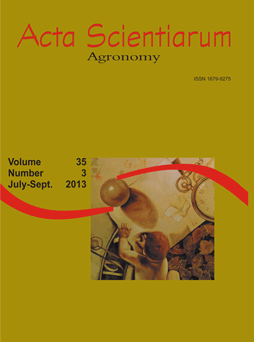<b>Arbuscular mycorrhizal fungi within agroforestry and traditional land use systems in semi-arid Northeast Brazil</b> - doi: 10.4025/actasciagron.v35i3.16213
Abstract
The diversity of arbuscular mycorrhizal fungi (AMF) can be a critical factor in enhancing both the productivity and the diversity of plants in ecosystems, and the plants in the ecosystem also strongly influence the occurrence of these fungi. The relationships between different land use systems and AMF communities in the semi-arid region of the State of Paraíba, NE Brazil were evaluated. The experiment followed a split-plot randomized block design, with four replicates. The main plots were defined by the presence or absence of trees (gliricidia and maniçoba), while the split plots were defined by three land use systems: 1) traditional cropping of maize + beans, 2) buffel grass pasture, and 3) prickly pear forage crop. The presence of trees increased sporulation, mycorrhizal colonization and the production of infective propagules of AMF in all three land use systems. Greater production of glomalin-related soil protein (GRSP) occurred in the prickly pear plots regardless of the presence or absence of trees. Species belonging to the Glomus genus predominated regardless of the presence of trees, land use systemor soil sampling period.
Downloads
DECLARATION OF ORIGINALITY AND COPYRIGHTS
I Declare that current article is original and has not been submitted for publication, in part or in whole, to any other national or international journal.
The copyrights belong exclusively to the authors. Published content is licensed under Creative Commons Attribution 4.0 (CC BY 4.0) guidelines, which allows sharing (copy and distribution of the material in any medium or format) and adaptation (remix, transform, and build upon the material) for any purpose, even commercially, under the terms of attribution.




















































